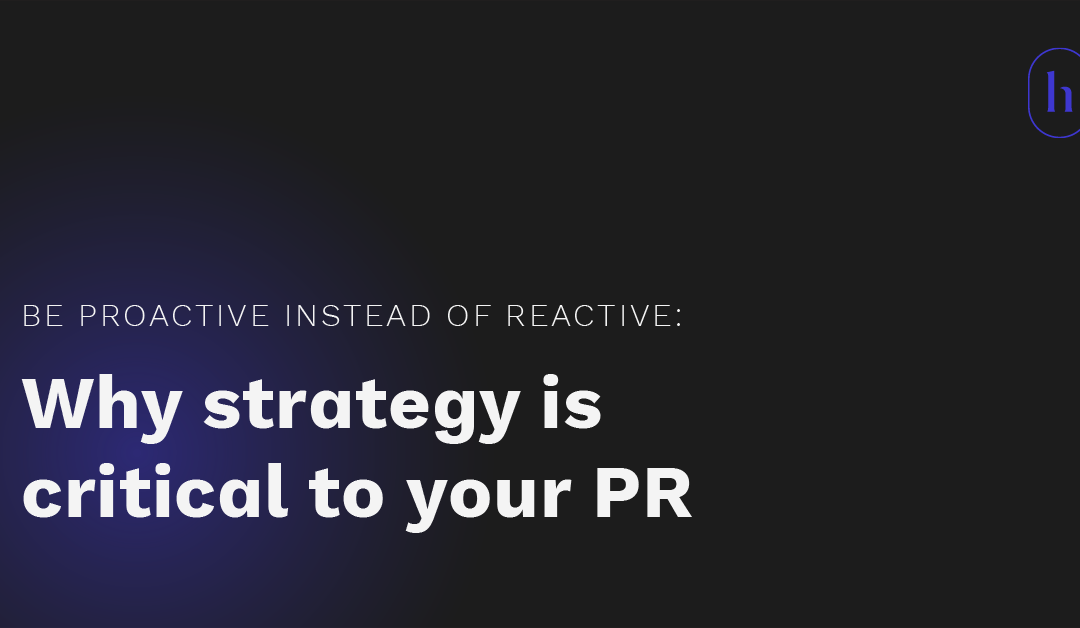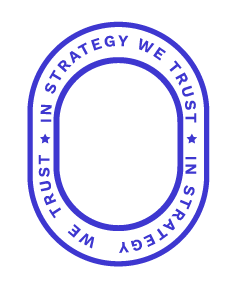
Public Relations
Be proactive instead of reactive:
Why PR strategy is critical
Public relations is often revered as reactivity to negative news or situations. While it’s great to be able to think on your feet and handle a crisis or new event when it comes along, a well-developed marketing strategy goes a long way in keeping your brand’s awareness high throughout the year.
Having a strategic plan for your public relations means you can create content to promote your brand throughout the year and be ready if you do see an immediate crisis.
Here are our top five tips for being proactive with your PR:
Schedule out what services or products you want to promote during different weeks or months. This will help you plan your messaging and make sure you have the product availability for when you do your push.
This will also help you ensure that you are continuously working on something to promote your brand and keeping your content as fresh as possible. Review your public relations calendar with your team and with all public touchpoints so your messaging stays consistent.
Special days, special promotions
There are several holidays and observances throughout the year where you can promote your business in a fun and creative way. With nationally dedicated days for nearly every food, activity, or type of person, there are countless opportunities for you to engage with and energize your audience.
Serious topics like drowning prevention month and medical awareness months can be an opportunity to partner with your community for education purposes through sponsorships or personal stories from your team on how your services can help solve problems.
Keeping on top of these events goes a long way in making sure you are part of the conversation beyond running sales or events around major holidays.
A great proactive PR plan will include pitching story ideas to the local media, including “experts” from your business who can speak on relevant topics.
Here are some examples of this:
- During back-to-school time, a chiropractor’s office might pitch an expert to talk about backpack weights and tips to prevent kids from carrying too much.
- When it comes time for New Year’s resolutions, gyms often encourage their trainers to talk about routines or nutrition.
- When summer is around the corner, a local daycare could promote expert activity ideas that parents can do at home with their kids.
- When an unexpected pandemic hits, many businesses might pitch their stay-at-home solutions for the upheaval in everyone’s lives.
While not all these pitches lead to direct sales, they create brand awareness and leverage your business as an expert source so when a potential client needs what you offer, your business is at the top of their mind.
The time to be reactive to a crisis may arise, but proactively preparing for an emergency can make the process much smoother and less stressful.
Here are some strategies you can put in place:
- Make sure you have a communications plan – who does the talking, who approves messaging, etc.
- Have access to make immediate updates to the website, social media, voicemail messaging, customer e-mails, if necessary.
- Identify what your primary means of communication to your customers will be during a crisis and make plans to funnel all other channels to that main source.
- Double-check that all media and community leader contacts are up to date.
By creating a crisis management public relations strategy, you can ensure minimal impact on your brand’s image during a disaster.
Having a deep understanding of your brand’s message, audience, and values will help you stay on track during a crisis. Take the time to research your plan so you can target the right message to the right audience.
Some questions that can be answered through PR research and planning include:
- Who is my target audience? What demographics would be most interested in my products?
- Why is this product or service important to them? How will this make a difference in their lives?
- Which type of communication does this audience respond best to?
- What are my competitors doing successfully?
- What do we offer that sets us apart from our competitors?
Finding the answers to these questions while building your PR strategy helps avoid wasteful and ineffective marketing strategies and ensures you can target a specific audience that will be the most interested in what you have to offer.
Reactive PR is usually a necessary part of business, but being proactive should be as well. Both help you plan for your business’s future, protect your image, and work in conjunction with the marketing you’re already doing. If you’re not getting proactive with your PR, it’s time to make it an essential part of your marketing plan.

Communication, Public Relations, Strategy
Did you participate in fire drills at school? If the fire alarm goes off in your building – do you know what to do? We prepare for that danger, but it’s important to be ready for whatever crisis may come.
Weather, world events, technical difficulties, and yes, even global pandemics throw a wrench in our lives. And for businesses, these events can put the brakes on everything. And while you are scrambling to problem-solve, your customers or clients are contacting you for information and updates.
You need a plan. You don’t wait until you’re in the middle of the fire to talk about what should be done. There’s no need to wait until a crisis hits to scramble for ways to communicate.
When an ice storm hits, and you need to close or cancel appointments – how will your patrons be notified? If a negative tweet about your organization goes viral – how can you respond in a way that won’t add flame to the fire? What happens if your Internet, power, or water goes out? Or of your systems are hacked and your customers’ private data is breached?
This might cause you to feel slightly panicked about the future, rest assured there is really no need to freak out. You’ve got this! Especially if you have a good crisis communication plan. When there is an issue, there are a few questions that your crisis communication plan can help answer:
Who Will Communicate?
Sometimes when a crisis is happening, leaders can feel like they are being pulled in a million directions. Plagued with solving the problem at hand while communicating to employees, clients, and the community can be daunting.
And like a game of telephone that we played as kids, a message can get confused when it comes through many different sources. Having a communication plan prepares you to designate someone to speak to the public, respond to phone calls, and manage social media while you work to come up with solutions and resolve the crisis.
Knowing ahead of time who you can trust to show grace under pressure and get accurate and timely information goes a long way. Someone who is proactive and not reactive when it comes to crisis communication can help save your business’ reputation.
The old adage tells us that if you can’t say something nice, don’t say anything at all. But when your business is in crisis and you can’t afford to keep quiet, having someone who may communicate impulsively can do a lot of damage. Waiting until a crisis occurs to find the right person for the job is not the best idea for such a critical role.
How Will They Communicate?
Figuring out who will get your messages out is half the battle. Most businesses wait until they are in the middle of a situation to decide how they are going to notify their community of what is happening. But in a crisis, not all your communication methods may be functioning.
Here are some issues to consider:
- How will you communicate if you are without power or Internet access?
- If you normally send people to your website for the latest information – what happens if you cannot get ahold of your web content manager during the crisis? What if their updates take 24 hours to publish and your clients need current information?
- If you have someone else doing your social media – do you have access to the accounts in case they are unavailable for updates?
- Do you have a paper list with the contact information for key stakeholders in your business that you may need to access if you can’t get online?
- Can you direct all your clients to one website or social media page for updates?
Having a crisis communication plan helps you answer most of these questions ahead of time, and that your entire team will know what to do when it happens.
What Will They Communicate
Even if you assign a person to handle your communications during a crisis, you will still need to have a plan in place for how they will have the latest information approved by you. Information can change by the minute sometimes, and you want to make sure you are not passing along a message only to have to change it five minutes later.
Who signs off on communications before it is sent? Do you have a regular update schedule, so your clients, customers, or employees don’t go for too long without information?
With a proper crisis communication plan, you and your team will be able to handle whatever crisis comes your way without panicking. While it seems like extra work now, it will save you time later if it is needed.
If you need help with any of this – strategy, planning, or training please contact us. We would be happy to have a consultation with you to discuss your needs and budget and find a solution that will work for you and your team.
by mollymason | June 27, 2016 | Marketing, Strategy | 0 Comments
Let’s pretend it’s a warm, sunny day and we’re running a lemonade stand. You walk by, purchase a cup, and declare “Wow! That is some seriously good lemonade. What do you guys do so different?” Truthfully, a recipe isn’t that hard to follow: proper portions of water,...
by mollymason | June 27, 2016 | Marketing, Strategy | 0 Comments
Let’s pretend it’s a warm, sunny day and we’re running a lemonade stand. You walk by, purchase a cup, and declare “Wow! That is some seriously good lemonade. What do you guys do so different?” Truthfully, a recipe isn’t that hard to follow: proper portions of water,...

Branding, Marketing, Public Relations, Strategy

Is it just me, or has the world of marketing been going a little too well over the past few weeks? It seems as though there was a faint ticking sound coming from the marketing campaign time bomb, just waiting to blow.
Since the unfortunate airing of the Kendall Jenner Pepsi commercial or the United Airlines passenger mishap, there really hasn’t been any exciting marketing and PR news. Well, that all changed last week when Bedrock Detroit decided to launch its “See Detroit Like We Do” campaign. I wouldn’t necessarily say I’m pleased that another campaign finally fell through the cracks, but you must agree that it was long overdue.

For those of you who haven’t seen it yet, Bedrock Detroit placed a sign with the slogan “See Detroit Like We Do,” that filled the windows along the ground level of a building in downtown Detroit. That doesn’t sound too bad, right? Wrong. The photograph featured mostly white individuals in a city that is widely known for its diverse culture.
Yikes! Now What?
How companies handle unfortunate situations like the Bedrock Campaign is crucial for their ongoing success. Luckily, Dan Gilbert, founder of Bedrock Detroit and Quicken Loans, was able to address the situation with both speed and grace. “We screwed up badly the graphic package that was partially installed on the retail windows of the first floor of the Vinton Building, in downtown Detroit,” Gilbert said in an open letter posted on Bedrock Detroit’s Facebook page.

“Although not intended to create the kind of feelings it did, the slogan/statement we used on these graphics was tone deaf, in poor taste and does not reflect a single value or philosophy that we stand for at Bedrock Development or in our entire Family of companies,” the letter said. “We have killed the ‘See Detroit Like We Do’ campaign.” It looks like someone payed attention in public relations class! Bravo, Dan.
So, What Did We Learn?
The mistakes that companies make can be very detrimental to both their finances and public image. This is where the PR department must weigh its options; to act or not to act—that is the question.
- Act. And act quickly. When bad news hits you directly, you need to respond immediately.
- Give your organization a face. At this point you’re already dealing with bad publicity, so you want to present your company as one which people can connect with.
- Present the facts. Considering the media driven world we live in, many situations become twisted and can make your situation out to be worse than it is, so act truthfully.
- Be transparent. Allowing people to see how and why things went wrong can help your image in the future.
- Own up to your mistakes. Aside from acting quickly, this might be the most important step. People don’t want to hear the run-around of excuses. Admit your faults and move on.
- Be sincere. Most people can cut through a lot of business talk and empty words. If they can hear sincerity, they are more likely to be forgiving.
While it is somewhat unsettling to see our fellow marketers make these mistakes, it’s an eye-opening experience for anyone involved—particularly the audience. Put yourself in their shoes; see your message through their eyes. You don’t want to be the one to set off that ticking time bomb.
Branding, Communication, Public Relations

Imagine that you’re taking your child to their first driving lesson, and out of nowhere, a car cuts you off and the driver is yelling at you. A few moments later, you pull up to the driving school to see the same person is now your child’s driving instructor. More than likely, you would take your child somewhere else. I’m not saying that you have to be a robot, but it’s important to be aware of your actions. Whether you’re on the clock or not, being a positive advocate for your brand is important.
React Wisely
I’m no wizard. Therefore, I can’t control when unexpected things happen to me. But, I can control the way I react to them. Showing self-control on tough situations tells people a lot about your character, which reflects positively on your brand.
Don’t be average
Demonstrate that your brand is unique. While attending networking events, make it a point to engage with everyone in the room, not just key people. Go above and beyond the norm. Learn about their interests and goals, so that you can offer support or advice. This builds trust, an important factor in business decisions.
When people trust you, your brand will speak for itself.
If you can successfully reach out and influence others positively, they will never forget about you.

Communication, Marketing, Public Relations, Social, Strategy

The age of posting excessive pictures of your fancy drinks and fun foods on social media has arrived. Since the dawn of social media, people have captured photos and posted them online for the world to see. But now, everywhere you turn someone is seeking the perfect lighting for a picture of the newest vegan soup, or for the case of this discussion, the newest Starbucks drink.
But I love Starbucks…
There is no denying that Starbucks is dominating the Café industry, but have they gone too far? The new Unicorn Frappuccino went from an internet sensation to a controversial lawsuit in a matter of weeks. The globally desired drink hit the shelves on April 19 and was said to be a limited time offer. Limited time offer…brilliant. Not only did they develop a drink that was social media gold, they scheduled it so that everyone would have to try it before it was too late. Even the customers who were unable to get their hands on one turned to social media. Only this time to vent their frustration. I guess it’s true what they say, there’s no such thing as bad publicity!
 PR specialists explain that the Unicorn Frappuccino was inspired by unicorn-themed food and drinks trending on social media, unicorn emojis, and the unicorn filter on Snapchat. Brooklyn café, The End, had a different opinion, saying that Starbucks ripped-off their already established drink called the Unicorn Latte. The End began selling the Unicorn Latte in December of 2016, and has had a pending trademark for the drink name since January of 2017. That said, The End isn’t the only small business with a unicorn-inspired drink on their menu. This mythical creature is truly taking the social media world by storm #magic.
PR specialists explain that the Unicorn Frappuccino was inspired by unicorn-themed food and drinks trending on social media, unicorn emojis, and the unicorn filter on Snapchat. Brooklyn café, The End, had a different opinion, saying that Starbucks ripped-off their already established drink called the Unicorn Latte. The End began selling the Unicorn Latte in December of 2016, and has had a pending trademark for the drink name since January of 2017. That said, The End isn’t the only small business with a unicorn-inspired drink on their menu. This mythical creature is truly taking the social media world by storm #magic.
The interesting thing about these trends is that companies often leave the marketing up to the consumers. Why dump millions of dollars on social media campaigns when your customers will go online and do it for you? Aside from the initial announcement of the new product, companies get to sit back and watch as we upload endless posts, making their product a desirable fixation.
Take away the sparkles and what are you left with?
As a millennial, I too have developed a love for social media. I’ll even share the occasional photo of decadent cocktails or colorful cuisine that I come across. The one thing I don’t understand is the obsession over these trends, especially when people don’t actually enjoy the product. Most folks who purchased the Unicorn Frappuccino said they didn’t like the taste, claiming it tasted like sour milk.
There’s nothing magical about sour milk. I don’t care how sparkly or mystical it looks, if it tastes like dairy-gone-bad we should be tagging it the #DirtyDonkeyFrappe.
Communication, Marketing, Public Relations
United Airlines issued a report last week outlining changes in policy to prevent another incident like the one that occurred in April. After violently removing a passenger from one of their flights, their response to the situation was less than ideal.
“I breached public trust with this event and how we responded,” Munoz told The Associated Press. “People are upset, and I suspect that there are a lot of people potentially thinking of not flying us.”
United Airlines is finally admitting they didn’t respond effectively to the situation. Earlier, I talked about what this incident can teach us about public relations.
 I can’t stop thinking about this situation, though. I want to know why it happened. How it happened.
I can’t stop thinking about this situation, though. I want to know why it happened. How it happened.
Between United Airlines and the Kendell Jenner Pepsi Ad, there have been some high profile mishaps in the marketing universe. Pepsi created an ad intending to show they were cutting edge, on the edge of social change. As soon it aired, public outcry demanded it be removed. It was seen as racist, elitist, and everything that is wrong with our society.
I don’t think I’m alone in wondering how they got there. How did the in-house Pepsi team sit in a room and approve that ad? Why did it take United Airlines so very long to realize the error of their ways?
I Have a Theory
 Have you ever heard of groupthink? First defined in 1972 by Irving Janis, this communication theory illustrates when a group comes to a unanimous wrong decision despite facts that point to a different outcome. Basically, the group cares more about group cohesiveness, approval, and everyone feeling “good” about the decision and being “right”. Options get overlooked, opinions are left unsaid, and critiques are withheld. This often leads to terrible results – some famous examples include the Challenger disaster and the Bay of Pigs invasion.
Have you ever heard of groupthink? First defined in 1972 by Irving Janis, this communication theory illustrates when a group comes to a unanimous wrong decision despite facts that point to a different outcome. Basically, the group cares more about group cohesiveness, approval, and everyone feeling “good” about the decision and being “right”. Options get overlooked, opinions are left unsaid, and critiques are withheld. This often leads to terrible results – some famous examples include the Challenger disaster and the Bay of Pigs invasion.
I believe groupthink played a large role in both United Airlines and Pepsi’s decision making.
It makes you wonder – are you guilty of groupthink in your organization? What about tunnel vision or having a myopic outlook? All things that work together to create a perfect storm of bad decision making.
Groupthink Quiz
Here’s a quick quiz to help you determine if you are guilty of groupthink – answer yes to one of these questions and maybe it’s time to put some preventive measures in place.
- Are people in your organization afraid to offer an alternative opinion that goes against the majority? How do you know that they are not? Do you have anonymous survey data to back that up?

- Do most of your meetings seem very harmonious with absolutely no discussion or disagreement? There can sometimes be too much of a good thing.
- Do you avoid bringing in an outside opinion or perspective? When’s the last time that happened?
- Does the leader of your organization give their opinion before everyone has chimed in?
- Do you assume silence by any member means they agree with the majority?
Why It Matters
In the case of United Airlines and Pepsi, the outcome of their bad decision making has been quite devastating. They are now dealing with the following:
- Dramatic drop of stock prices immediately following the incidents
- Negative publicity
- Demolition of their company image
- Legal ramifications
- Potential loss of future revenue
To grow as an organization, it’s important to take constant stock on both your internal and external communication strategies. Sometimes, that adjustment is a slight pivot, and other times it requires a giant leap in a different direction.
Groupthink has led to some terrible outcomes for companies and consumers. Don’t be the next example of what not to do.













 PR specialists explain that the Unicorn Frappuccino was inspired by unicorn-themed food and drinks trending on social media, unicorn emojis, and the unicorn filter on Snapchat. Brooklyn café,
PR specialists explain that the Unicorn Frappuccino was inspired by unicorn-themed food and drinks trending on social media, unicorn emojis, and the unicorn filter on Snapchat. Brooklyn café,  I can’t stop thinking about this situation, though. I want to know why it happened. How it happened.
I can’t stop thinking about this situation, though. I want to know why it happened. How it happened. Have you ever heard of groupthink? First defined in 1972 by Irving Janis, this
Have you ever heard of groupthink? First defined in 1972 by Irving Janis, this 